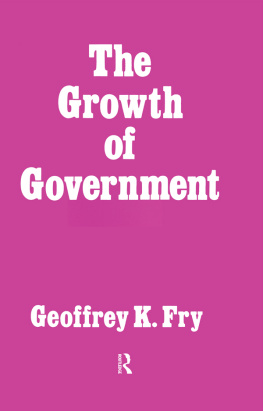First published 1995 by Prentice Hall/Harvester Wheatsheaf
Published 2014 by Routledge
2 Park Square, Milton Park, Abingdon, Oxon OX14 4RN
711 Third Avenue, New York, NY 10017
Routledge is an imprint of the Taylor & Francis Group, an informa business
Copyright 1995 Geoffrey K. Fry
All rights reserved. No part of this book may be reprinted or reproduced or utilised in any form or by any electronic, mechanical, or other means, now known or hereafter invented, including photocopying and recording, or in any information storage or retrieval system, without permission in writing from the publishers.
Notices
Knowledge and best practice in this field are constantly changing. As new research and experience broaden our understanding, changes in research methods, professional practices, or medical treatment may become necessary.
Practitioners and researchers must always rely on their own experience and knowledge in evaluating and using any information, methods, compounds, or experiments described herein. In using such information or methods they should be mindful of their own safety and the safety of others, including parties for whom they have a professional responsibility.
To the fullest extent of the law, neither the Publisher nor the authors, contributors, or editors, assume any liability for any injury and/or damage to persons or property as a matter of products liability, negligence or otherwise, or from any use or operation of any methods, products, instructions, or ideas contained in the material herein.
ISBN 13:978-0-13-353830-4 (pbk)
Library of Congress Cataloging-in-Publication Data
Fry, Geoffrey Kingdom.
Policy and management in the British Civil Service/Geoffrey K.
Fry.
p. cm.
Includes bibliographical references (p.) and index.
ISBN 0-13-353830-3 (alk. paper)
1. Civil service reformGreat Britain.2. Civil serviceGreat
Britain.3. Great BritainPolitics and government1979
I. Title.
JN428.F78 1995
354.41004dc20
95-8786
CIP
British Library Cataloguing in Publication Data
A catalogue record for this book is available from the British Library
Typeset in 10/12 pt Sabon
To Harry and Joan Hanson
This book is about the British Civil Service since 1979 and about the origins of the changes which have taken place. It is not a textbook, but an interpretative essay of assessment.
To judge from past experience, and as would be expected, not all readers will agree with the assessment made. This has certainly been so before. A book of mine called The Administrative Revolution in Whitehall, published in 1981, was dismissive about the importance of the changes made in the machinery of government in the 1960s and 1970s, hence the inverted commas. This upset those who had earnestly chronicled changes which should have been recognised at the time, and not merely later, to have been mainly cosmetic and usually worthless. Then again, while the historical material in my book, Statesmen in Disguise (1969) was accepted, the criticisms made about the work of the Fulton Committee offended against the conformity of the day. Yet who now thinks that the Fulton Report was radical? The changes since 1979 were viewed with caution in another of my books, The Changing Civil Service (1985), and in academic articles. What has taken place in the British Civil Service since 1979 does not seem to me to fit either of the two famous explanations of patterns of administrative change, the Lindblom incrementalist model and the Elton revolutionary model, both discussed in Chapter 6 of this book. Yet, especially since the Next Steps Report of 1988, and certainly by the standards of the past, the order of change since 1979 seems remarkable, and only that which took place in and around the two world wars, particularly the Second World War, seems at all comparable in importance. In those periods, though, the Civil Service was being built up. Now, it may be being broken up. Some might call this a counter-revolution, as would befit a Conservative revolution. Some would hope for a restoration, a reaction, a return to normalcy, to the days before 1979, or at least before the true date, 1988. Whether or not the changes have been revolutionary (and one of their major architects thinks not), they have been of a scale and importance which invites analysis.
The writer is well aware of the changes that have been taking place in the Civil Services of other countries, and the text, bibliography and references bear testimony to this. Nevertheless, each country is different, which is what makes them interesting, and recent British experience owes surprisingly little to outside examples. Indeed, Britains closest outside relationship, that with the European Union, involves bureaucratic expansionism.
The Treasury and the Office of Public Service and Science, and that departments predecessors, have been generous to the author with their time and help with material for this book. I am grateful to Sir Robin Butler, the Head of the Home Civil Service, for permission to have access to the papers of the Fulton Committee within the period of the Thirty Year Rule, and to produce related material in this book. The work was funded by ESRC Award Number R000231033.1 am grateful to Dr Ann Gold for permission to have access to, and to quote from, the papers of Lord Boyle, and I am grateful also to the Chairman of the Conservative Party for access to archive material, as I am to the Keeper of Public Records and the Controller of HM Stationery Office for permission to quote from material that is subject to Crown copyright. I am grateful to K.A.G. Murray, formerly of the Civil Service Commission, for making available to me material that was privately published. I am grateful as well to the editors of Political Studies, Public Administration and Public Policy and Administration for permission to use material published in another form in those journals.
As in earlier books, I am indebted to those who debate Civil Service issues, although I rarely, if ever, share their views. This is true of The Economist newspaper. I record with thanks the help given in particular by the Civil and Public Services Association, the National Union of Civil and Public Servants, the Institution of Professionals, Managers and Specialists, the Association of First Division Civil Servants and the Council of Civil Service Unions. When the Whitley Bulletin was first issued in 1921, it was intended to be a journal of record about the Civil Service. It fulfilled this role admirably, as did The Bulletin of the Civil Service Unions, which was its successor. The Bulletin ceased publication at the end of 1994 because there was insufficient central Civil Service material for it to record. This illustrates the radical nature of the recent changes in the Civil Service.
It is the case that I could not have completed this book, or the others before it, without the facilities of, and the help of the staff employed in, the Brother-ton Library of the University of Leeds, and I acknowledge the professionalism shown.
As with earlier books too, I have had considerable help and encouragement from colleagues at the University of Leeds. Gordon Forster, Christopher Challis, Kevin Theakston and Duncan McCargo helped me this time, and, as before, the polymath, Owen Hartley provided invaluable support. I take full responsibility for what is written in this book.













